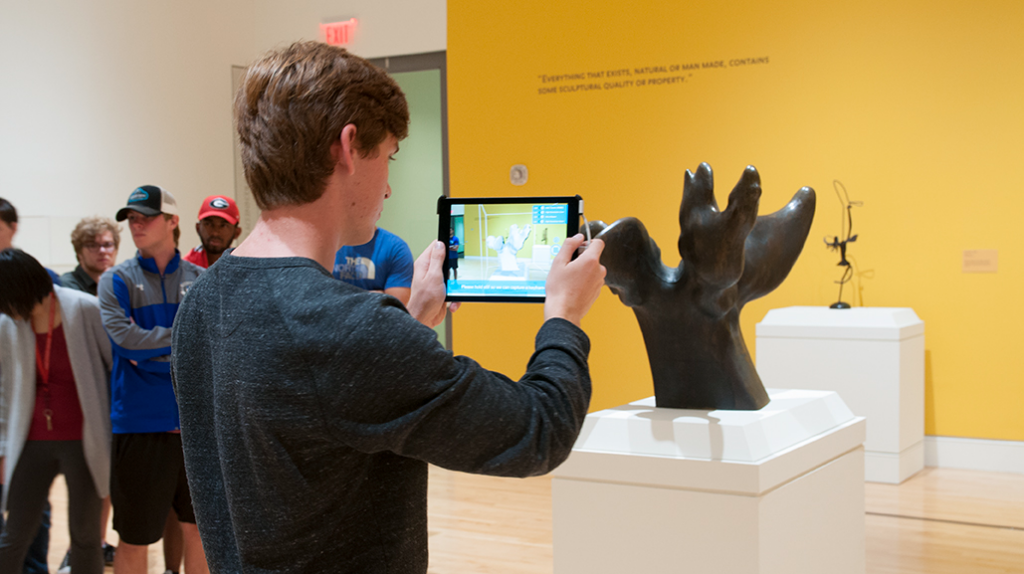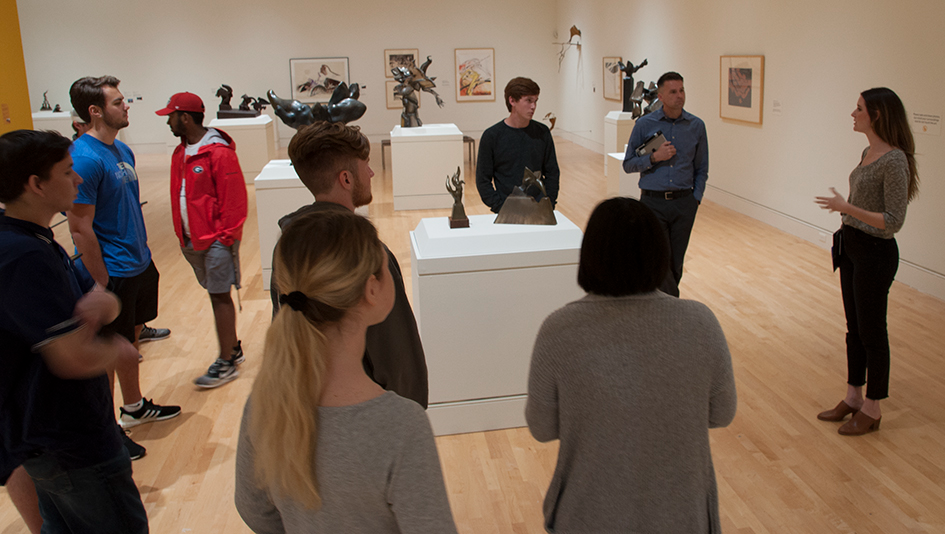
The 15 students in Suraj Sharma’s First-Year Odyssey Seminar “3D Printing and Design” watched with anticipation as the sculptures developed layer by layer right before their eyes. For most of them, it was their first experience with a 3D printer. For all of them, it was an introduction to technology in a way they never before explored.
As an associate professor in the Department of Textiles, Merchandising, and Interiors, Sharma’s research combines science and technology fundamentals with textile design in his quest to develop more advanced, renewable biomaterials and textiles. Pulling from his years of research in sustainable materials and smart textiles, Sharma created a hands-on First-Year Odyssey Seminar that provided students with an opportunity to explore 3D printing technology and introduced them to UGA’s numerous resources.
His course originated with his first FYOS in 2012 that focused on the potential of turning algae into bioplastics, a technique he developed through research and allowed ALGIX company to leverage this technology in commercializing in Mississippi that used the material as feedstock for 3D printing.
3D printing quickly became an essential part of Sharma’s work, as many of the components used in his research were built using 3D printers—including the flexible material which he recently discovered produced electricity when combined with body movement. Realizing the potential of 3D printing, he began to include more 3D printing instruction into his curriculum, so students could learn how to apply the skills to various types of research fields and career paths.
This was first achieved when he received a grant in 2016 from the Center for Teaching and Learning to incorporate 3D printing and the flipped classroom into textile education. He then broadened the scope of 3D printing instruction through the 3D Printing and Design FYO seminar, teaching students with a wide range of majors and backgrounds about the endless applications of 3D printing.
“You have tremendous potential to make anything out of 3D printing,” he said. “It gives students a lot of opportunities to [use] their creativity, learn about those basic skills [and] how to develop those designs.”
Students in Sharma’s FYOS applied their new knowledge of 3D printing to scan and print miniature replicas of Richard Hunt sculptures in an exhibit at the Georgia Museum of Art, led by Callan Steinmann, curator of education. Andrew Johnson, UGA’s Emerging Technologies Librarian, showed the students how to scan detailed images of the sculptures on an iPad scanning app, and then helped them edit the images in the 3D printing software Tinkercad and MakerBot. The students then worked in teams in the Science Library Makerspace, where they watched their hard work come to life on the 3D printers.

UGA definitely gives us a huge opportunity to delve into this technology…I’m very grateful for what it offers,” said Brian Nelson. The intended computer systems engineering major was excited to see how technology has evolved and how the 3D printer technologies can be applied to STEM disciplines to construct components for engineering, medical and research projects.
UGA’s First-Year Odyssey Seminars are intended to introduce first-year students to academics and research at UGA, while giving them the opportunity to explore the campus community and resources and engage with faculty and students in a small class setting. Sharma introduced his students to his research through a 3D printing experience, while educating them about resources at UGA with the help of Johnson and Steinmann.
“I [had] never been to the Museum of Art here…I didn’t know that that was available for us and that it’s free for us to use,” said Nelson.
Sharma’s successes in incorporating 3D printing into curriculum were enhanced by the inclusion of the Science Library Makerspace, where Johnson offers free training sessions for any UGA student or staff in a variety of new technologies, from 3D Scanners and printers, to laser cutters, to virtual reality.
“The big thing with 3D printing is rapid prototyping,” Johnson explained to Sharma’s class as they worked to produce their replicated sculptures from the GMOA. He explained how different variables in 3D printing impact the final product. He showed them how to manipulate the weight of a printed object by adjusting the amount of filament (the biodegradable material fed from the 3D printer) and creating a hollow inside the shape, as well as how to print more quickly without losing resolution quality by adjusting layer height. Throughout the course, students developed innovative thinking and analytical skills that can be applied to just about any career, in an ever-increasing variety of ways.
Working with these cutting-edge technologies as freshmen gave students the opportunity to think outside of the box, enabling them to consider creative ways to enhance their majors and fields of interest with technological innovation.
“The process is much more creative than I expected it to be,” said computer science major Kelsey Henton. “When it comes to 3D printing, it’s graphics, it’s kind of creating your own thing, using your imagination. You’re just more able to do whatever you want to do and follow your own path.”
Students also learned new technical skills to take their unique ideas to the next stages of development, regardless of background or level of expertise.
“[It’s] really rewarding,” Sharma said. “By yourself, designing and assembling things…you feel more fulfilled.”
By teaching his first-year students about emerging technologies, Sharma opened their minds to the limitless possibilities of innovation and research, and showed them how to apply these concepts to their majors and career goals, whether in art, engineering, medical research or just for fun.
“In the next ten years something even greater than [3D printing] that we don’t even [know about] could be possible,” said Nelson. “That’s why I think what I’m doing right now at UGA, just the field of STEM and technology in general, is just really interesting, because it’s growing at such a fast rate.”
